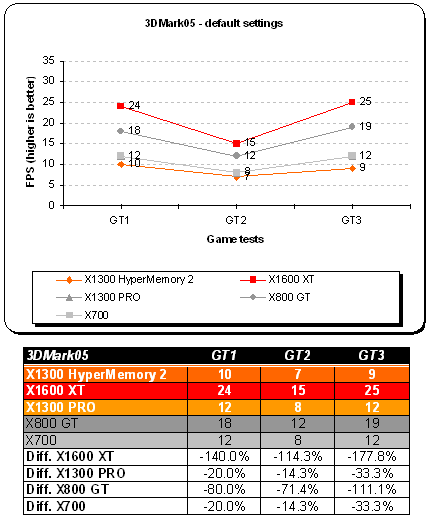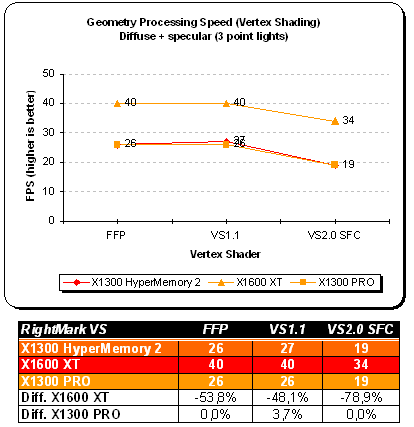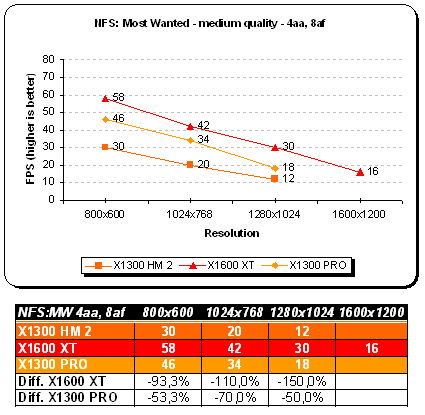This product is intended for folks with less gaming on their minds. Don’t get me wrong, it’s great for SFF systems, multimedia platforms and some light gaming. You can still play any recent game with low details and get respectable frame rates, but that’s about it. To my understanding, the 64-bit memory architecture was used to diversify different X1300 SKUs. If you feel you need more juice, get the 128-bit version instead. It will cost you no extra buck as both products have been positioned at the same price point. After all you can’t expect revolutionary gaming experience for $79 green right?
Introduction
Because not everyone can shell out $500+ green for a video card, I decided to review the PowerColor X1600 XT and X1300 not so long ago. On February 21st, Tul Corporation announeced another low-end model based around RV515, the PowerColor X1300 HyperMemory™ 2 (RV515LE). With the PowerColor X1900 XT review behind us, I thought it would be fun and interesting to check out these cheap boards as well.
Remember the X1300 model I already reviewed was sporting 256MB of onboard DDR2 RAM with a 128-bit architecture. Is it even possible to get “cheaper” than that? Well, with HyperMemory technology, companies can reduce RAM costs by having the graphics card utilize some of your system memory. However, with low-end products, such as X300 / X1300, it’s usually a mere 5-10 FPS increase.
As you’ve already guessed, I’m checking out the PowerColor X1300 HyperMemory™ 2 today. What’s interesting is it sports a frame buffer of up to 512MB. Crazy, considering that much memory can be found only on performance and enthusiast parts. What’s troubling, however, is the memory architectur,e which is only 64-bit and natively 128MB of onboard memory.
Also, the size of the card can be a deciding factor when going for a low-end model with full DirectX 9.0 support (including Shader Model 3.0).

VPU Specifications
While most specs can be found here, let me just recap some of them here. RADEON X1300 (RV515 / LE) can process up to 128 threads, 1/4 of what R520 can do. It sports 4 ROPs (no double-Z, however), 4 texture units as well as 4 shader units and 2 vertex units. The RV515LE is very specific because it’s used for HyperMemory™ 2 boards with 64-bit memory buses. They support up to 512MB of RAM (onboard 128MB, 384 MB shared) and of course Fetch4 technology.
More right below.

X1300 Specifications
- Features
-
- 105 million transistors on 90nm fabrication process
- Four pixel shader processors
- Two vertex shader processors
- 128-bit 4-channel DDR/DDR2/GDDR3 memory interface
- 32-bit/1-channel, 64-bit/2-channel, and 128-bit/4-channel configurations
- Native PCI Express x16 bus interface
- AGP 8x configurations also supported with external bridge chip
- Dynamic Voltage Control
- High Performance Memory Controller
-
- Fully associative texture, color, and Z/stencil cache designs
- Hierarchical Z-buffer with Early Z test
- Lossless Z Compression (up to 48:1)
- Fast Z-Buffer Clear
- Z/stencil xache optimized for real-time shadow rendering
- Ultra-Threaded Shader Engine
-
- Support for Microsoft® DirectX® 9.0 Shader Model 3.0 programmable vertex and pixel shaders in hardware
- Full speed 128-bit floating point processing for all shader operations
- Up to 128 simultaneous pixel threads
- Dedicated branch execution units for high performance dynamic branching and flow control
- Dedicated texture address units for improved efficiency
- 3Dc+ texture compression
- High quality 4:1 compression for normal maps and two-channel data formats
- High quality 2:1 compression for luminance maps and single-channel data formats
- Multiple Render Target (MRT) support
- Render to vertex buffer support
- Complete feature set also supported in OpenGL® 2.0
- Advanced Image Quality Features
-
- 64-bit floating point HDR rendering supported throughout the pipeline
- Includes support for blending and multi-sample anti-aliasing
- 32-bit integer HDR (10:10:10:2) format supported throughout the pipeline
- Includes support for blending and multi-sample anti-aliasing
- 2x/4x/6x Anti-Aliasing modes
- Multi-sample algorithm with gamma correction, programmable sparse sample patterns, and centroid sampling
- New Adaptive Anti-Aliasing feature with Performance and Quality modes
- Temporal Anti-Aliasing mode
- Lossless Color Compression (up to 6:1) at all resolutions, including widescreen HDTV resolutions
- 2x/4x/8x/16x Anisotropic Filtering modes
- Up to 128-tap texture filtering
- Adaptive algorithm with Performance and Quality options
- High resolution texture support (up to 4k x 4k)
- 64-bit floating point HDR rendering supported throughout the pipeline
- Avivo™ Video and Display Platform
-
- High performance programmable video processor
- Accelerated MPEG-2, MPEG-4, DivX, WMV9, VC-1, and H.264 decoding and transcoding
- DXVA support
- De-blocking and noise reduction filtering
- Motion compensation, IDCT, DCT and color space conversion
- Vector adaptive per-pixel de-interlacing
- 3:2 pulldown (frame rate conversion)
- Seamless integration of pixel shaders with video in real time
- HDR tone mapping acceleration
- Maps any input format to 10 bit per channel output
- Flexible display support
- Dual integrated DVI transmitters (one dual-link + one single-link)
- DVI 1.0 compliant / HDMI interoperable and HDCP ready
- Dual integrated 10 bit per channel 400 MHz DACs
- 16 bit per channel floating point HDR and 10 bit per channel DVI output
- Programmable piecewise linear gamma correction, color correction, and color space conversion (10 bits per color)
- Complete, independent color controls and video overlays for each display
- High quality pre- and post-scaling engines, with underscan support for all outputs
- Content-adaptive de-flicker filtering for interlaced displays
- Xilleon™ TV encoder for high quality analog output
- YPrPb component output for direct drive of HDTV displays*
- Spatial/temporal dithering enables 10-bit color quality on 8-bit and 6-bit displays
- Fast, glitch-free mode switching
- VGA mode support on all outputs
- Drive two displays simultaneously with independent resolutions and refresh rates
- Dual integrated DVI transmitters (one dual-link + one single-link)
- Compatible with ATI TV/Video encoder products, including Theater 550
- High performance programmable video processor
- CrossFire™
-
- Multi-GPU technology
- Inter-GPU communication over PCI Express (no interlink hardware required)
- Four modes of operation:
- Alternate Frame Rendering (maximum performance)
- Supertiling (optimal load-balancing)
- Scissor (compatibility)
- Super AA 8x/10x/12x/14x (maximum image quality)
- Multi-GPU technology
- HyperMemory™ 2
-
- 2nd generation virtual memory management technology
- Improved PCI Express transfer efficiency
- Supports rendering to system memory as well as local graphics memory
- 2nd generation virtual memory management technology
The Card
The low-end segment is probably the most popular one. OEMs tend to put in their systems rather slow cards to cut the cost of the whole package. We at Bjorn3D don’t review many of those cards, but along came another opportunity, so I couldn’t resist.
Let me present you the card in question…
Click a picture to see a larger view
The dimensions should not scare anyone away. The board is small (even smaller than a regular X1300) and will fit into any system with a PCI Express slot. The cooling slapped on the X1300 is also a reference design. This particular card is equipped with 128MB of memory and an additional shared 384MB used from system. The total of 512MB is available for the card’s use. PowerColor X1300 HyperMemory™ 2 sports single DVI-I output, regular VGA output and TV-out. The card carries a standard display support: VGA compatible, VESA compatible BIOS for SVGA and DDC 1/2b/2b+.
As far as memory, I found same Hynix GDDR2 memory chips that can be found on the PowerColor X1300: HY5PS561621AFP-25 rated at 400MHz inside 84Ball FBGA package.
Bundle
This section is rather for those who want to see what’s inside instead of looking at the outside. If you’re looking for any games, you’ll be disappointed — you won’t find any at all (which is common of cards in this segment).
Click a picture to see a larger view
The card I received looks like an early sample, packed in a white box instead of a retail one. Also, if you look above, you’ll find a CD-ROM with a newer BIOS, which ups the GPU core to 600 MHz (from 400 MHz). As far as I know, retail boards will come already equipped with the 600MHz BIOS. Additionally, there is a composite cable and included ATI drivers.
The already mentioned bundle. No games, just:
Accessories
- Composite Cable
- Quick start manual
Software
- ATI drivers
Setup and Installation
All of our benchmarks were run on an Athlon 64 3000+ system with clock at 2.5GHz. I’m stacking the PowerColor X1300 HyperMemory™ 2 against a PowerColor X1600 XT and another X1300 (with 128-bit memory bus). Additionally, I will throw in 3DMark05 scores from a X700. The overclocking section will consist of 3DMark05 scores from different cards. The table below shows the test system configuration as well benchmarks used throughout this comparison.
| Components | – DFI NF4 Ultra-D – Athlon64 3000+ Venice – 2x256MB Corsair PC3200LLP (Dual Channel) – Thermaltake 520 Watt PSU – PowerColor X1300 HyperMemory™ 2 – PowerColor X1600 XT – PowerColor X1300 |
| Software | – Windows XP SP2 – DirectX 9.0c – nForce4 6.53 drivers – CATALYST 6.2 |
| Synthetic Benchmarks | – 3DMark 2005 v1.2.0 – D3D Right Mark 1.0.5.0 beta 4 |
| Gaming Benchmarks | – F.E.A.R / ingame benchmark + Fraps – Half-Life 2 / custom d13c17 timedemo + Fraps – Doom 3 / default timedemo + Fraps – NFS: Most Wanted / Fraps |
| Notes | CPU clocked at 2.5GHz |
Important CATALYST notes:
For X1600 XT
CATALYST A.I: standard
Mipmap detail level: quality
For X1300
CATALYST A.I: advanced
Mipmap detail level: quality
Synthetic Benchmarks
3DMark05
I’ve used Futuremark’s 3DMark05 to measure the actual throughput of the PowerColor X1300 HyperMemory™ 2 and compared it against a few other candidates: X1600 XT, X1300, X700 and X800 XT. Below are the results.

RightMark
D3D RightMark is a very useful tool for measuring different theoretical throughputs of a graphics chip. I ran a couple of synthetic tests to stress out the new X1300. The main focus of theses tests will be to stress out Geometric Processing (Vertex Shading) as well as Pixel Shader units.
With D3D RightMark, you will be able to get the following information about your video card:
- Features supported by your video card
- Pixel Fillrate and Texel Fillrate
- Pixel shader processing speed (all shader models)
- Vertex shader (geometry) processing speed (all shader models)
- Point sprites drawing speed
- HSR efficency

F.E.A.R.
The game has been made over at Monolith Productions studio and has been out for quite some time. Since a lot of you are interested in seeing how it plays, I’ve decided to give it a shot and bench it with our little X1300 HyperMemory™ 2 from PowerColor.
Game Overview
An unidentified paramilitary force infiltrates a multi-billion dollar aerospace compound, taking hostages but issuing no demands. The government responds by sending in special forces, but loses contact as an eerie signal interrupts radio communications. When the interference subsides moments later, the team has been obliterated. As part of a classified strike team created to deal with threats no one else can handle, your mission is simple: Eliminate the intruders at any cost. Determine the origin of the signal. And contain the crisis before it spirals out of control.
As you probably know, F.E.A.R. uses a very sophisticated game engine (FEAR).
- Rendering
- FEAR is powered by a new flexible, extensible, and data driven DirectX 9 renderer that uses materials for rendering all visual objects. Each material associates an HLSL shader with artist-editable parameters used for rendering, including texture maps (normal, specular, emissive, etc.), colors, and numeric constants.
- Lightning Model
- FEAR features a unified Blinn-Phong per-pixel lighting model, allowing each light to generate both diffuse and specular lighting consistently across all solid objects in the environment. The lighting pipeline uses the following passes:
- Emissive: The emissive pass allows objects to display a glow effect and establishes the depth buffer to improve performance.
- Lighting: The lighting pass renders each light, first by generating shadows and then by applying the lighting onto any pixels that are visible and not shadowed.
- Translucency: The translucent pass blends all translucent objects into the scene using back to front sorting.
- FEAR features a unified Blinn-Phong per-pixel lighting model, allowing each light to generate both diffuse and specular lighting consistently across all solid objects in the environment. The lighting pipeline uses the following passes:
- Visual Effects
- FEAR features a new optimized, data driven effects system that allows for the creation of key-framed effects that can be comprised of dynamic lights, particle systems, models, and sounds. Examples of the effects that can be created using this system include weapon muzzle flashes, explosions, footsteps, fire, snow, steam, smoke, dust, and debris.
- Sample Lights
- FEAR’s lighting model is very flexible and allows developers to easily add new lights. Existing lights include:
- Point Light: The point light is a single point that emits light equally in all directions.
- Spotlight: Similar to a flashlight, the spotlight projects light within a specified field of view. The spotlight can also use a texture to tint the color of the lighting on a per pixel basis.
- Cube Projector: Similar to the point light, the cube projector uses a cubic texture to tint each lit pixel.
- Directional Light: This lighting is emitted from a rectangular plane and is used to simulate directional lights like sunlight.
- Point Fill: Although similar to the point light, the point fill is an efficient option because it does not utilize specular lighting or cast shadows.
- FEAR’s lighting model is very flexible and allows developers to easily add new lights. Existing lights include:
A more detailed overview of other F.E.A.R. technologies can be found over at Touchdown Entertainment. These include: Havok Physics Engine and Modeling / Animations System.

Half-Life 2
We all love Half-Life 2, and we all want the best performance out of our hardware. This has to be one of the most graphic demanding games currently on the market. Half-Life 2 is built around the Source engine, which utilizes a very wide range of DirectX 8 / 9 special effects. Those include:
- Diffuse / specular bump mapping
- Dynamic soft shadows
- Localized / global valumetric fog
- Dynamic refraction
- High Level-of-Detail (LOD)
Note that users with DirectX 7 and older hardware (NVIDIA MX series for example) will not be able to enjoy the above effects.

Doom 3
Although this game needs no introduction, I will go over some of the game features and technology behind Doom 3. It took the guys at id Software over four years to complete this project. Lead programmer, John Carmack spent an awful lot of time designing the game engine, but his hard work paid off — to some extent since this is first title which houses the Doom 3 engine.
Let’s look at some of the engine tech features that are present in Doom 3:
- Unified lighting and shadowing engine
- Dynamic per-pixel lightning
- Stencil shadowing
- Specular lightning
- Realistic bumpmapping
- Dynamic and ambient six-channel audio
However you look at it, Carmack’s lighting engine is the essence of Doom 3. With OpenGL being the primary API, shaders have been put to a heavy use in order to create the realistically looking environment. Instead of using lightmaps, the game engine now processes all shadows in real-time. This technique is called stencil shadowing, which can accurately shadow other objects in the scene. There are disadvantages to this method however:
- Requires a lot of fillrate
- Fast CPU is needed for shadow calculations
- Inability to render soft shadows

Need For Speed: Most Wanted
We have quite a few sequels in this review, and this is another one. This time it’s from Electronic Arts. If you’ve played NFS Hot Pursuit, you know what I’m talking about. There are a lot of ideas taken out from the older NFS. The main difference between Most Wanted and Underground (in terms of graphics) is the addition of HDR-type effects. It’s pseudo-HDR (more like bloom), but it looks lovely nonetheless. Additionally, the game sports flashy new reflections, better object geometry, improved lightning system and finally physics engine.

Overclocking and Conclusions
Since the card I’m reviewing is an engineering sample, Tul included an updated BIOS that ups the GPU clock from 400MHz to 600MHz. I was told that the retail product will not require such an update. Instead, all cards will be flashed to resemble new speeds. As for memory, things do not look too bright from where I see it. It seems memory overclocking has been locked and that was done on purpose. Besides, the card’s RAM already runs at maximum frequency of 400MHz (800MHz DDR), so there is little room left anyway.
The core did not overclock as high as regular the PowerColor X1300, but I was able to reach 675MHz without any lockups or artifacts.

This product is intended for folks with less gaming on their minds. Don’t get me wrong, it’s great for SFF systems, multimedia platforms and some light gaming. You can still play any recent game with low details and get respectable frame rates, but that’s about it. To my understanding, the 64-bit memory architecture was used to diversify different X1300 SKUs. If you feel you need more juice, get the 128-bit version instead. It will cost you no extra buck as both products have been positioned at the same price point. After all, you can’t expect a revolutionary gaming experience for $79 right?
Pros:
+ Small design
+ Uses up to 512MB of RAM
Cons:
– 64-bit memory bus
– Mediocre performance
– No game bundle
 Bjorn3D.com Bjorn3d.com – Satisfying Your Daily Tech Cravings Since 1996
Bjorn3D.com Bjorn3d.com – Satisfying Your Daily Tech Cravings Since 1996

















